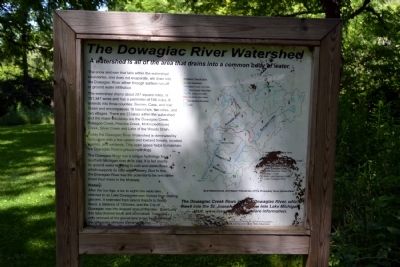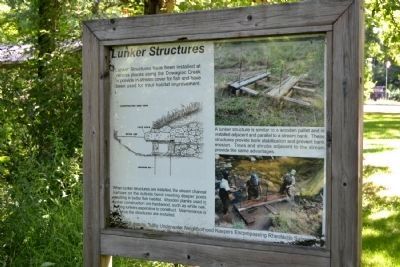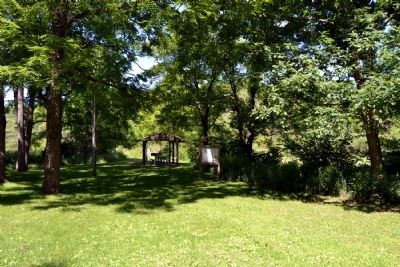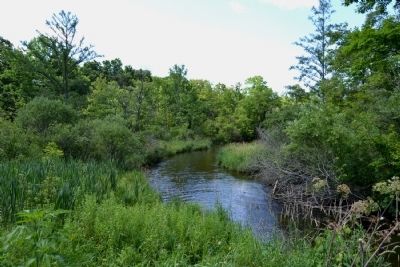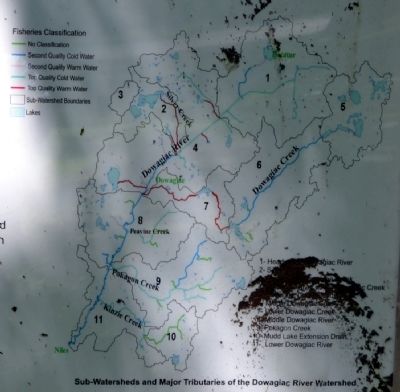Near Dowagiac in Cass County, Michigan — The American Midwest (Great Lakes)
The Dowagiac River Watershed / Lunker Structures
Inscription.
(Side One)
The Dowagiac River Watershed
A watershed is all of the area that drains into a common body of water.
The snow and rain that falls within the watershed boundaries, and does not evaporate, will drain into the Dowagiac River either through surface run-off or ground water infiltration.
The watershed drains about 287 square miles, or 181,347 acres and has a perimeter of 108 miles. It extends into three counties: Berrien, Cass, and Van Buren and encompasses 16 townships, two cities, and two villages. There are 23 lakes within the watershed and the major tributaries are the Dowagiac Creek, Pokagon Creek, Peavine Creek, McKinzie(Kinzie) Creek, Silver Creek and Lake of the Woods Drain.
Today the Dowagiac River Watershed is dominated by agriculture with a few upland and lowland forests, isolated prairies, and wetlands. This open space helps to maintain the Dowagiac River’s unique hydrology.
The Dowagiac River has a unique hydrology for a southern Michigan river of its size. It is fed mostly by ground water resulting in cold and stable flows, which supports its cold water fishery. Due to this, the Dowagiac River has the potential to be one of the finest trout rivers in the Midwest.
History:
After the Ice Age, a six to eight mile wide lake referred to as a Lake Dowagiake was formed from melting glaciers. It extended from Grand Rapids to South Bend, a distance of 120 miles, and the City of Dowagiac was the deepest area of the lake. Eventually this lake drained south and diminished. Today the only remnant of the glacial lake is two small lakes on the University of Notre Dame campus.
The Dowagiac Creek flows into the Dowagiac River, which flows into the St. Joseph River and on into Lake Michigan.
(Side Two)
Lunker Structures
Lunker structures have been installed at various places along the Dowagiac Creek to provide in-stream cover for fish and have been used for trout habitat improvement.
A lunker structure is similar to a wooden pallet and is installed adjacent and parallel to a stream bank. These structures provide bank stabilization and prevent bank erosion. Trees and shrubs adjacent to the stream provide the same advantages.
When lunker structures are installed, the stream channel narrows on the outside bend creating deeper pools resulting in better fish habitat. Wooden planks used in lunker construction are hardwood, such as white oak, making lunkers expensive to construct. Maintenance is low once the structures are installed.
LUNKERS means: “Little Underwater Neighborhood Keepers Encompassing Rheotactic Salmon”
Erected by St. Deny’s Foundation, MEANDRS, and the Cass County Parks Department.
Topics. This historical marker is listed in this topic list: Environment.
Location. 42° 0.689′ N, 85° 57.717′ W. Marker is near Dowagiac, Michigan, in Cass County. Marker can be reached from Marcellus Highway, 0.4 miles west of Gards Prairie Road. Marker is located in Fred Russ Forest Park west of the parking lot; above directions are to the entrance to the park. Touch for map. Marker is at or near this postal address: 20379 Marcellus Highway, Dowagiac MI 49047, United States of America. Touch for directions.
Other nearby markers. At least 8 other markers are within 7 miles of this marker, measured as the crow flies. Big Tree (within shouting distance of this marker); Newton House (approx. 0.3 miles away); Pickett's Corner (approx. 3.6 miles away); Cass County Veterans Memorial (approx. 6.2 miles away); A Station of the Underground Railway (approx. 6.4 miles away); Captain Iven C. Kincheloe Memorial (approx. 6.7 miles away); Decatur Township Hall (approx. 6.8 miles away); The Kentucky Raid (approx. 6.9 miles away). Touch for a list and map of all markers in Dowagiac.
Also see . . . Dowagiac River Watershed Project. Information on the Dowagiac River watershed, the Watershed Project, and Watershed Management Plan from
the Southwest Michigan Planning Commission website. (Submitted on July 15, 2014.)
Credits. This page was last revised on April 1, 2024. It was originally submitted on July 15, 2014, by Duane Hall of Abilene, Texas. This page has been viewed 559 times since then and 30 times this year. Photos: 1, 2, 3, 4, 5. submitted on July 15, 2014, by Duane Hall of Abilene, Texas.
